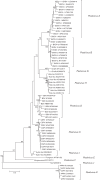Proposed revision to the taxonomy of the genus Pestivirus, family Flaviviridae
- PMID: 28786787
- PMCID: PMC5656787
- DOI: 10.1099/jgv.0.000873
Proposed revision to the taxonomy of the genus Pestivirus, family Flaviviridae
Abstract
We propose the creation of seven new species in the genus Pestivirus (family Flaviviridae) in addition to the four existing species, and naming species in a host-independent manner using the format Pestivirus X. Only the virus species names would change; virus isolates would still be referred to by their original names. The original species would be re-designated as Pestivirus A (original designation Bovine viral diarrhea virus 1), Pestivirus B (Bovine viral diarrhea virus 2), Pestivirus C (Classical swine fever virus) and Pestivirus D (Border disease virus). The seven new species (and example isolates) would be Pestivirus E (pronghorn pestivirus), Pestivirus F (Bungowannah virus), Pestivirus G (giraffe pestivirus), Pestivirus H (Hobi-like pestivirus), Pestivirus I (Aydin-like pestivirus), Pestivirus J (rat pestivirus) and Pestivirus K (atypical porcine pestivirus). A bat-derived virus and pestiviruses identified from sheep and goat (Tunisian sheep pestiviruses), which lack complete coding region sequences, may represent two additional species.
Figures


References
MeSH terms
Grants and funding
LinkOut - more resources
Full Text Sources
Other Literature Sources

